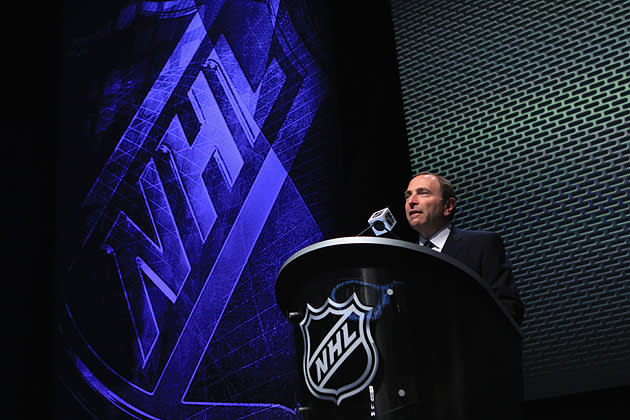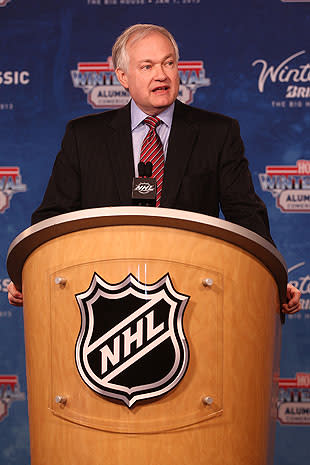The Player: What’s really at stake for NHLPA in collective bargaining with NHL

(The Player is an active member of a National Hockey League team. Anonymous by choice, he will provide insights about life in hockey on occasion throughout the season.)
There is one question I am asked quite frequently these days. It seems to be on the minds of hockey fans everywhere:
"Is there going to be a lockout?"
The answer I give, and it's an honest one, is that I don't know.
Even with the first bargaining sessions between the NHL Players' Association and the NHL in the books, there are still too many unknowns at this point to make any real predictions. I tell people that until both sides make their opening positions clear to one another, no one can really know how difficult it's going to be to find common ground.
Having said all that: If the rumors are true and the NHL proposes to bring the player's share of hockey related revenues (HRR) down to 50 percent, that could elicit a push-back from the players.
Cue the groans at this point; as in, "Here we go again."
Let's assume that the 50/50 split is indeed close to what the League has in mind. A lot of fans might think that sounds fair — after all, NFL players recently agreed to approximately 47 percent of revenues while their NBA counterparts bargained for a share closer to even.
On the flip side, MLB operates without a salary cap and has enjoyed a longer lasting labor peace than the rest of us.
The position of professional athletes within their organizations differs from that of most people because not only are they the employees, but they are also the product.
What, then, is "fair?"
I would caution anyone following this process to abandon any traditional ideas of what is "fair" or "unfair." In a negotiation of this magnitude, both sides will be looking for the best deal possible for their collective membership. Period. The owners will try to take whatever they think they can get, as is their right, and so should we.
The starting point in this negotiation rests on the history of what happened in the lockout of 2004. For those of you who have forgotten, we'll take a quick trip down memory lane.
The League argued that the economic system at the time was untenable, particularly for the small market (and some Canadian) teams. A salary cap was needed to give clubs "cost certainty" — to level the playing field for all teams — and help control ticket prices. How has that last one worked out for you, fans?
Bettman claimed League-wide losses of around $300 million. On the other side, the players wanted to work in a free market system, not artificially constrained by a salary cap. We contended that salaries had only risen to a level that owners and GMs had been willing to pay — a level they felt they could afford. We felt that it wasn't only competitive balance the League was seeking but, more importantly, to improve the bottom lines of the clubs and increase the value of the franchises.
Ultimately the owners won, and they won big. Or so it seemed at the time.
Players would receive 54 percent of HRR, and this number would be used to calculate the mid-point of the salary cap. The hard cap would be $8 million above that mid-point and the salary floor would be $8 million below it. To get to this artificially low number, the players took a 24-percent rollback on all existing contracts. In addition, the NHL and the NHLPA bargained for a revenue sharing system to help transfer money from the haves to the have-nots.
That agreement was ratified by the players in the summer of 2005; that season, the League played with a cap of $39 million and a floor of $23 million.
Fast forward to this past season, and the players' growing share (now 57 percent) of growing revenues (about $3.3 billion) meant that the cap had risen to approximately $64 million. Which means that the salary floor was $48 million, or $11 million (28 percent) more than the upper limit had been seven years earlier.
The good news is that the NHL had seven straight seasons of record revenues.
The bad news, for some teams, is that the increases in revenue haven't been evenly distributed, making it increasingly difficult for them to spend even to the floor.
I will share some simple numbers with you that I suspect will contribute to the players' skepticism if Gary Bettman and the clubs bring some of the same arguments this time around. These numbers are all ballpark figures, for simplicity's sake.
In 2003-2004, the final season before the lockout, players' salaries ate up about 74 percent of all the revenue generated by the NHL. In that year, the business was worth about $2 billion.
As we know, in 2011-2012 players received 57 percent of the revenues, which are believed to be in the neighborhood of $3.3 billion. So, over the course of that time revenues have increased by over 50 percent while player costs have only increased by about 15 percent.
In real terms, the amount of money that the owners have "saved" since 2004 — that is the difference between paying the players three quarters of revenues vs. 57 percent of revenues — is in excess of $3 billion.
If the League asks us to reduce our share to a straight 50/50 split, thus lowering the cap via what amounts to a 12.3-percent rollback, our question will be, "Why?"
One could predict that the NHL will concede that while some teams are doing well, others are barely hanging on. If that is the case, is it the players' responsibility to bail them out? Haven't we been down that road before?
Bettman got the system he wanted, one that he assured us would give us 30 healthy teams. My opinion is that if we have teams that are "sick," as we surely do, then simply re-setting salaries once again will neither be palatable to the players nor will it really fix the problem. Not in the long term. History has shown us that.
Clearly the system, as it exists now, does not work for everyone. If we simply roll back salaries again, who's to say we won't find ourselves in the same position five or seven years from now? Once reset, the cap (and the floor) will simply rise again over time as revenues rise.
Then we are back to square one.
If we are going to be serious about creating an environment in which all teams can be financially successful, then it's going to take considerably more thought than simply reducing the cap by 10-15 percent. Maybe there are some markets in which it's simply not realistic to expect that the situation can be salvaged. I don't know.
The players want all the teams to succeed, and to do so in their current locations. With that said, there are probably some cases in which revenues could be improved via relocation. Look at the bump in revenues that the players and the League enjoyed with the Atlanta to Winnipeg move. The players have no input into these matters and share in none of the relocation fees. We do, however, share in the benefits of healthy, profitable franchises.
The question is: How do we get there, and who is ultimately responsible for getting us there?
I believe a new approach is needed and I would like to see revenue sharing as a big part of the solution.
"But the NHL already has revenue sharing," you might say. Unfortunately the revenue sharing we have now doesn't work. Not really. It's not meaningful in the way that it is in the NFL and MLB. It's often token, not to mention somewhat random and ridiculously complicated. The system is so convoluted that some clubs can't reasonably predict how much money they will receive from, or pay into, the pot. Or even if they will be involved in the revenue sharing at all.
Unpredictable factors include: The final escrow return, whether or not your team makes the playoffs, your final attendance numbers and whether you end up above or below the median in terms of revenue determine your revenue sharing fate.
The effect is that the price of success or failure can't necessarily be easily measured. How hard would you work to generate an extra $5 million in revenue if you were going to be "taxed" on 80 percent of it through revenue sharing? Or, worse still, not knowing how much you would have to give up? Potentially none at all.
The point is that it must be a difficult system under which to run a business. Going forward revenue sharing needs to be much simpler, much more predictable, and more meaningful. If, collectively, we need to support some of the struggling franchises, then the League needs to take on a greater share of the responsibility. It can not all be left up to the players once more.
As the NHL and NHLPA head into a summer of negotiations, the fans have every right to be apprehensive and frustrated with the forecasts of doom and gloom making the rounds. I can assure you that the players know we have a good thing going. I think if you had asked every player at the start of the 2011-2012 season if they felt another lockout was on the horizon, the overwhelming answer would have been "no." They would have cited record revenues and rising salaries and assumed things were, mostly, all good.
To state the obvious: The players don't want a lockout.
I believe, perhaps unlike last time, the owners don't want one either. It feels like too soon to fight again. I am confident there is a willingness on the players' side to negotiate in good faith and to get a deal. I am certain, though, that we will be looking for the other side to reciprocate. In any negotiation things tend to proceed amicably until one side offers something the other side finds completely unacceptable.
Then all bets are off.
Again, we appreciate what we have, but we believe we deserve a significant share of what the future will bring. Salaries continue to rise at a healthy rate every season. We also understand, though, that they have only done so because revenues have done the same.
The stakes, this time around, have risen considerably. The pie has grown, and the pieces have become more valuable. I am hopeful that both sides will look upon a work stoppage as a last resort and not as a bargaining tool. Because while there is more to gain then there was in 2004, there is also much more to lose.
(The Player is an active member of a National Hockey League team, anonymous by choice.)

 Yahoo Sports
Yahoo Sports 



